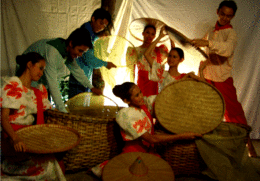Philippine dance
| Part of a series on the |
| Culture of the Philippines |
|---|
 |
| History |
| People |
| Languages |
| Traditions |
| Cuisine |
| Festivals |
| Religion |
| Art |
| Literature |
|
Music and performing arts |
|
Monuments |
|
| Life in the Philippines |
|---|
 |
As varied are the people of the Philippines, so too are the dances. There are many dances performed in the Philippine Islands such as the popular "Tinikling", to the exoticized "Pangalay", to the skill-based interpretation of the "Bangka" and Spanish-tinged "Jota". Dance categorizations range from geographic localization, to socialization functions, to dance influences, and to time traveling.
Geographic localization
Presentation of Dances in the Philippines are often categorized in ethnic or geographic localization. These localization are often presented in the following:
- Dances of the Cordillera Mountains (Igorot)
- Dances of the Taga-Ummah (Muslim)
- Dances of the Traditionalists (Lumad)
- Dances of the Low-land Western-Christians
Societal function
Other less common presentations of Philippine dances have been categorized by societal functions. Philippine dances not only convey the artistry of movement but, are often associated with a life-function such as a wedding, the mimicry of birds, or even the warding of evil spirits. This outlook on dance can be looked at in the following categories.
- Ritualistic dances
- Mimetic dances
- Life-cycle dances
- Party dances
Dance influences
Another presentation of dances is through contrasting the influences of Southeast and mainland Asia with the influences of the Spanish and Americans.
- Southeast Asian Influence
- Mainland Asian Influence
- Spanish Influences
- American Influences
Time periods
Dances of the Philippine needs to be looked at the Time-period in which they are taken. As culture is constantly evolving, dances often change along with the times. Philippine dance can be categorized in these time periods:
- Pre-colonial
- Spanish Colonial
- American Period
- Modern and Post-Modern
Contemporary outlook
As the popularity of the Pilipino Cultural Nights and the Folk Arts groups gain their ascendency, so too, does the need to create and recreate Philippine dance forms. Among these contemporary issues are the ideas of bringing the village dance into the stage, the connections among the various Philippine dance, the ownership of world-influence and the dances of Filipinos from the diaspora.
- From the Village to Stage
- Interconnection of Philippine Dance
- Filipinizing world influences
- Dances from the Diaspora
See also
References
- Dances of the Emerald Islesklentong
